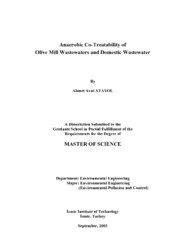Please use this identifier to cite or link to this item:
https://hdl.handle.net/11147/3526| Title: | Anaerobic Co-Treatability of Olive Mill Wastewaters and Domestic Wastewater | Authors: | Atayol, Ahmet Avni | Advisors: | Sofuoğlu, Aysun Sofuoğlu, Aysun |
Publisher: | Izmir Institute of Technology | Abstract: | Handling of olive mill wastewater (OMW) constitute an important problem for Mediterranean countries in general and western parts of Turkey in particular. This wastewater is seasonally produced and has high organic pollutant concentrations. Many treatment methods have been tried for its treatment, but a method having both sufficient treatment efficiency and economical feasibility could not be offered.Anaerobic treatment, having the advantages of applicability to high-strength and/or seasonal wastewaters, energy production and reduced costs, may be a good option. But olive mill wastewater is considered still to be highly polluted and not to have sufficient nutrients while domestic wastewater (DW) is assessed to be dilute and to have nutrients in excess for anaerobic treatment. Therefore anaerobic co-treatment of these wastewaters may be a better solution.In this study, the anaerobic co-treatability of OMW and DW was investigated by means of anaerobic treatability assays called Biochemical Methane Potential (BMP) tests. These tests were applied to OMW and DW mixtures of different ratios (OMW:DW of 1:9, 1:5, 1:3, 1:1, 1:0) at different organic loadings (4553 mg/l, 9107 mg/l, 13660 mg/l, 22767 mg/l and 34150 mg/l Chemical Oxygen Demand (COD) loading) with two different seed cultures. In order to determine the effect of nutrient addition, and the complementarity of these wastewaters, all tests were carried out both with (BM+) and without (BM-) the addition of a nutrient solution (basal medium).Results of the experiments showed treatment efficiencies around 80% at 4553 mg/l COD loading and around 70% at higher loadings for samples seeded with the culture obtained from the treatment plant of Efes Pilsen Brewery in İzmir, Turkey. For samples seeded with the culture obtained from the anaerobic digesters of Ankara Municipal Wastewater Treatment Plant, results were between 61% and 82% with the higher efficiencies at medium COD loading levels. A meaningful relation between DW content and treatment efficiency could not be observed; but the performance ratio of BMreactors to BM+ reactors increased with increasing DW content in the mixture, indicating the positive effect of DW addition. Reactors seeded with Efes culture did not require an acclimation period, while those seeded with Ankara culture did so. Efes seeded reactors, at all COD loadings, performed most of the gas production, around 75-80%, in about 15-20 days. Ankara seeded BM+ reactors required about 25 days for 80% production, while this period was about 35-45 days for BM- reactors. | Description: | Thesis (Master)--Izmir Institute of Technology, Environmental Engineering, İzmir, 2003 Includes bibliographical references (leaves: 53-58) Text in English; Abstract: Turkish and English xi 58 leaves |
URI: | http://hdl.handle.net/11147/3526 |
| Appears in Collections: | Master Degree / Yüksek Lisans Tezleri Sürdürülebilir Yeşil Kampüs Koleksiyonu / Sustainable Green Campus Collection |
Files in This Item:
| File | Description | Size | Format | |
|---|---|---|---|---|
| T000239.pdf | MasterThesis | 492.85 kB | Adobe PDF |  View/Open |
CORE Recommender
Page view(s)
374
checked on Jun 10, 2025
Download(s)
132
checked on Jun 10, 2025
Google ScholarTM
Check
Items in GCRIS Repository are protected by copyright, with all rights reserved, unless otherwise indicated.